Unemployment in Australia: Trends, Types, and Impacts Over Five Years
VerifiedAdded on 2020/05/16
|14
|3168
|220
Report
AI Summary
This report provides a comprehensive analysis of unemployment in Australia, examining trends over the last five years. It delves into different types of unemployment, including frictional, structural, and cyclical, and explores the impact of economic changes, technological advancements, and global market integration on the Australian labor market. The report highlights key issues such as youth unemployment, gender disparities in the workforce, and the challenges faced by immigrants. It presents statistical data and trends across different states, offering insights into the factors contributing to unemployment and their implications for the Australian economy. The analysis covers unemployment rates, labor force participation, and employment figures, providing a detailed overview of the labor market's performance and challenges.
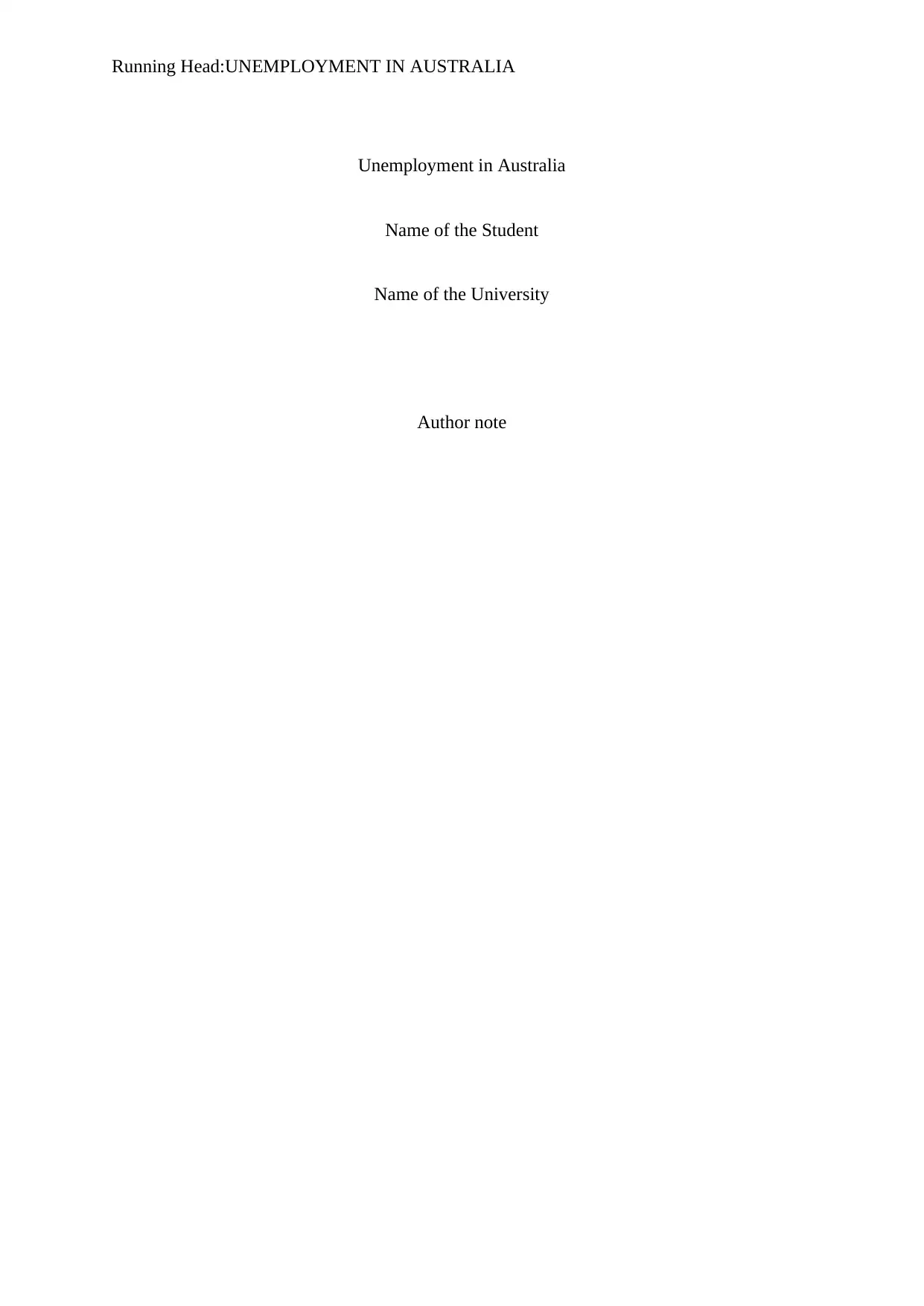
Running Head:UNEMPLOYMENT IN AUSTRALIA
Unemployment in Australia
Name of the Student
Name of the University
Author note
Unemployment in Australia
Name of the Student
Name of the University
Author note
Paraphrase This Document
Need a fresh take? Get an instant paraphrase of this document with our AI Paraphraser
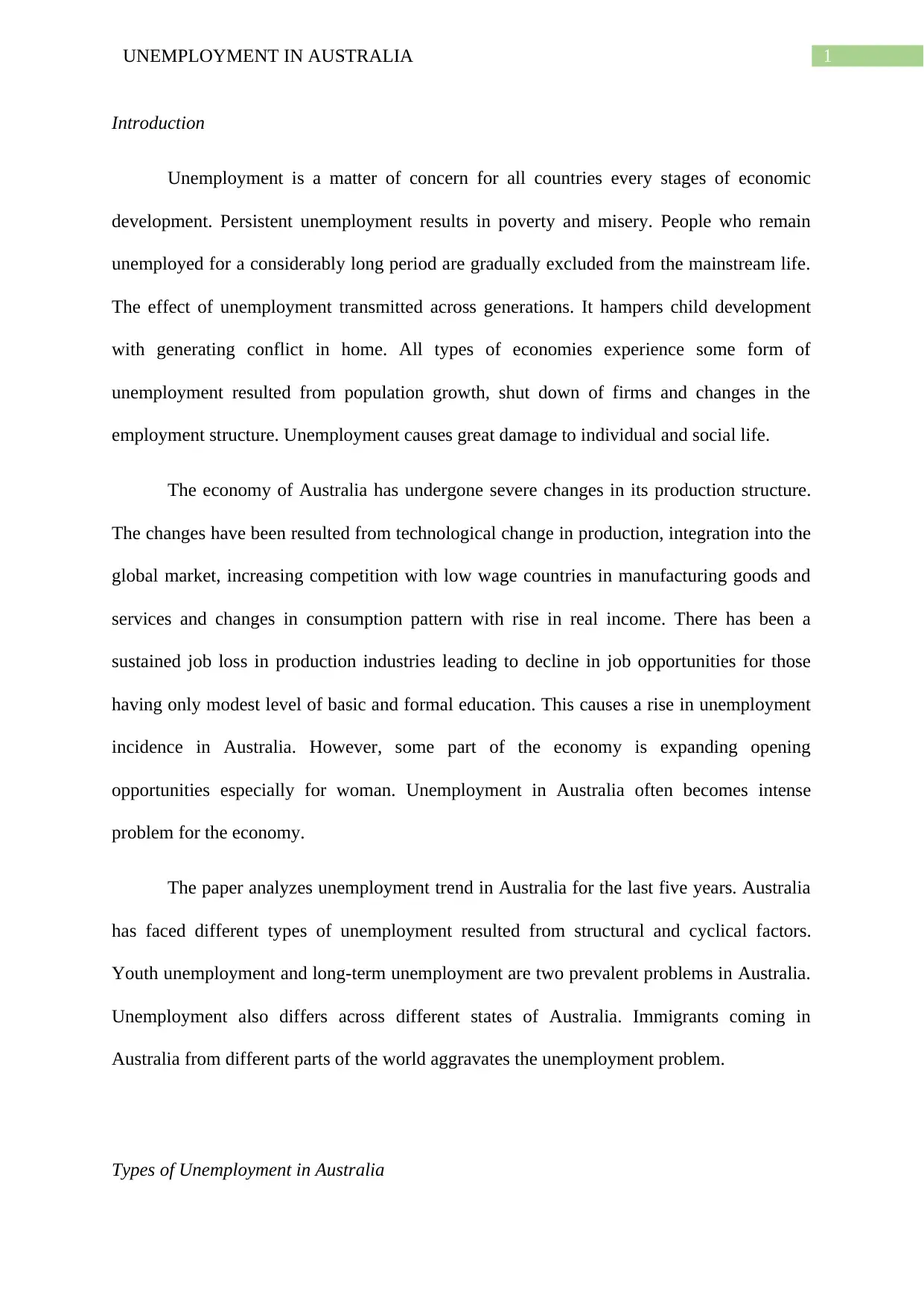
1UNEMPLOYMENT IN AUSTRALIA
Introduction
Unemployment is a matter of concern for all countries every stages of economic
development. Persistent unemployment results in poverty and misery. People who remain
unemployed for a considerably long period are gradually excluded from the mainstream life.
The effect of unemployment transmitted across generations. It hampers child development
with generating conflict in home. All types of economies experience some form of
unemployment resulted from population growth, shut down of firms and changes in the
employment structure. Unemployment causes great damage to individual and social life.
The economy of Australia has undergone severe changes in its production structure.
The changes have been resulted from technological change in production, integration into the
global market, increasing competition with low wage countries in manufacturing goods and
services and changes in consumption pattern with rise in real income. There has been a
sustained job loss in production industries leading to decline in job opportunities for those
having only modest level of basic and formal education. This causes a rise in unemployment
incidence in Australia. However, some part of the economy is expanding opening
opportunities especially for woman. Unemployment in Australia often becomes intense
problem for the economy.
The paper analyzes unemployment trend in Australia for the last five years. Australia
has faced different types of unemployment resulted from structural and cyclical factors.
Youth unemployment and long-term unemployment are two prevalent problems in Australia.
Unemployment also differs across different states of Australia. Immigrants coming in
Australia from different parts of the world aggravates the unemployment problem.
Types of Unemployment in Australia
Introduction
Unemployment is a matter of concern for all countries every stages of economic
development. Persistent unemployment results in poverty and misery. People who remain
unemployed for a considerably long period are gradually excluded from the mainstream life.
The effect of unemployment transmitted across generations. It hampers child development
with generating conflict in home. All types of economies experience some form of
unemployment resulted from population growth, shut down of firms and changes in the
employment structure. Unemployment causes great damage to individual and social life.
The economy of Australia has undergone severe changes in its production structure.
The changes have been resulted from technological change in production, integration into the
global market, increasing competition with low wage countries in manufacturing goods and
services and changes in consumption pattern with rise in real income. There has been a
sustained job loss in production industries leading to decline in job opportunities for those
having only modest level of basic and formal education. This causes a rise in unemployment
incidence in Australia. However, some part of the economy is expanding opening
opportunities especially for woman. Unemployment in Australia often becomes intense
problem for the economy.
The paper analyzes unemployment trend in Australia for the last five years. Australia
has faced different types of unemployment resulted from structural and cyclical factors.
Youth unemployment and long-term unemployment are two prevalent problems in Australia.
Unemployment also differs across different states of Australia. Immigrants coming in
Australia from different parts of the world aggravates the unemployment problem.
Types of Unemployment in Australia
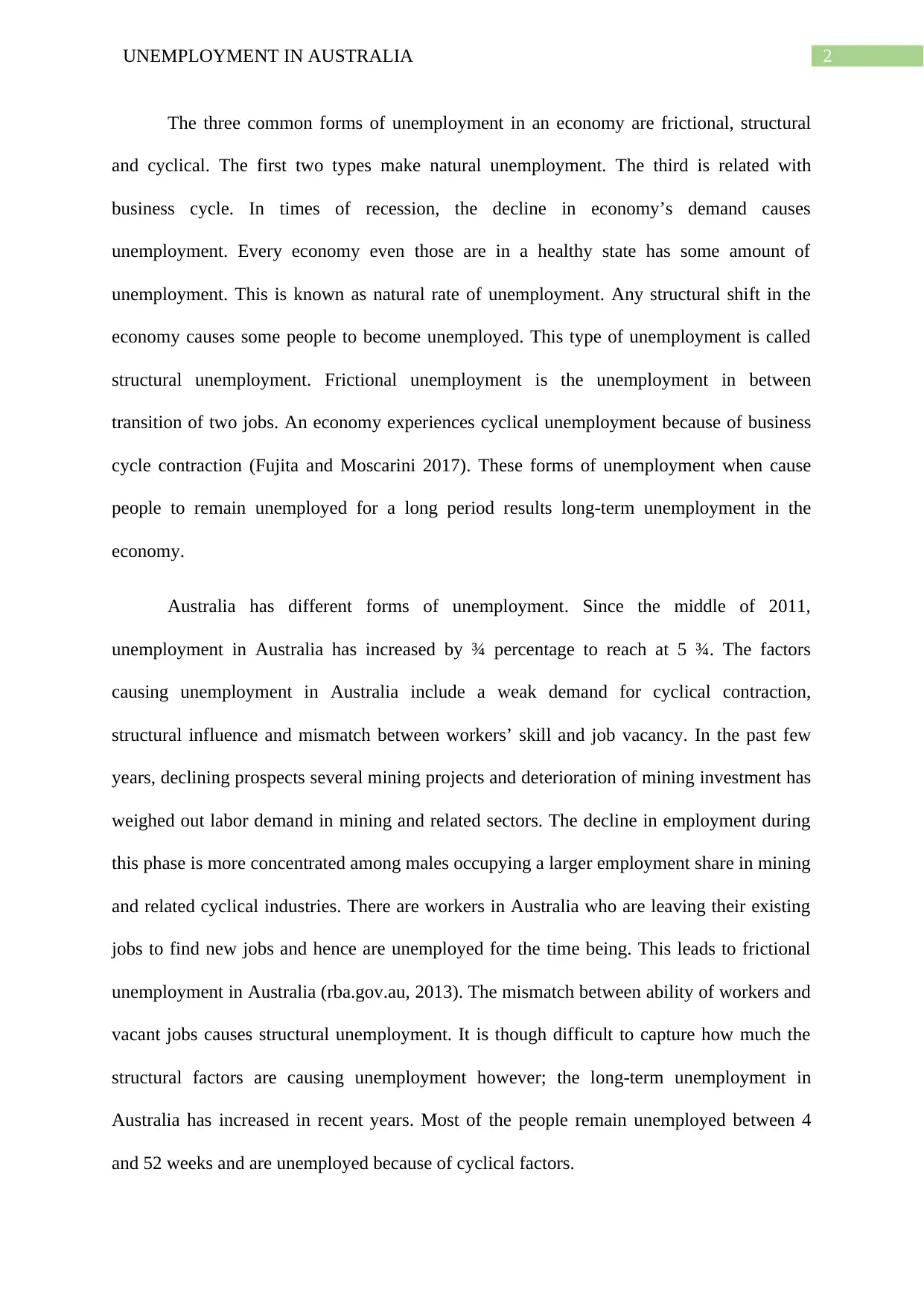
2UNEMPLOYMENT IN AUSTRALIA
The three common forms of unemployment in an economy are frictional, structural
and cyclical. The first two types make natural unemployment. The third is related with
business cycle. In times of recession, the decline in economy’s demand causes
unemployment. Every economy even those are in a healthy state has some amount of
unemployment. This is known as natural rate of unemployment. Any structural shift in the
economy causes some people to become unemployed. This type of unemployment is called
structural unemployment. Frictional unemployment is the unemployment in between
transition of two jobs. An economy experiences cyclical unemployment because of business
cycle contraction (Fujita and Moscarini 2017). These forms of unemployment when cause
people to remain unemployed for a long period results long-term unemployment in the
economy.
Australia has different forms of unemployment. Since the middle of 2011,
unemployment in Australia has increased by ¾ percentage to reach at 5 ¾. The factors
causing unemployment in Australia include a weak demand for cyclical contraction,
structural influence and mismatch between workers’ skill and job vacancy. In the past few
years, declining prospects several mining projects and deterioration of mining investment has
weighed out labor demand in mining and related sectors. The decline in employment during
this phase is more concentrated among males occupying a larger employment share in mining
and related cyclical industries. There are workers in Australia who are leaving their existing
jobs to find new jobs and hence are unemployed for the time being. This leads to frictional
unemployment in Australia (rba.gov.au, 2013). The mismatch between ability of workers and
vacant jobs causes structural unemployment. It is though difficult to capture how much the
structural factors are causing unemployment however; the long-term unemployment in
Australia has increased in recent years. Most of the people remain unemployed between 4
and 52 weeks and are unemployed because of cyclical factors.
The three common forms of unemployment in an economy are frictional, structural
and cyclical. The first two types make natural unemployment. The third is related with
business cycle. In times of recession, the decline in economy’s demand causes
unemployment. Every economy even those are in a healthy state has some amount of
unemployment. This is known as natural rate of unemployment. Any structural shift in the
economy causes some people to become unemployed. This type of unemployment is called
structural unemployment. Frictional unemployment is the unemployment in between
transition of two jobs. An economy experiences cyclical unemployment because of business
cycle contraction (Fujita and Moscarini 2017). These forms of unemployment when cause
people to remain unemployed for a long period results long-term unemployment in the
economy.
Australia has different forms of unemployment. Since the middle of 2011,
unemployment in Australia has increased by ¾ percentage to reach at 5 ¾. The factors
causing unemployment in Australia include a weak demand for cyclical contraction,
structural influence and mismatch between workers’ skill and job vacancy. In the past few
years, declining prospects several mining projects and deterioration of mining investment has
weighed out labor demand in mining and related sectors. The decline in employment during
this phase is more concentrated among males occupying a larger employment share in mining
and related cyclical industries. There are workers in Australia who are leaving their existing
jobs to find new jobs and hence are unemployed for the time being. This leads to frictional
unemployment in Australia (rba.gov.au, 2013). The mismatch between ability of workers and
vacant jobs causes structural unemployment. It is though difficult to capture how much the
structural factors are causing unemployment however; the long-term unemployment in
Australia has increased in recent years. Most of the people remain unemployed between 4
and 52 weeks and are unemployed because of cyclical factors.
⊘ This is a preview!⊘
Do you want full access?
Subscribe today to unlock all pages.

Trusted by 1+ million students worldwide
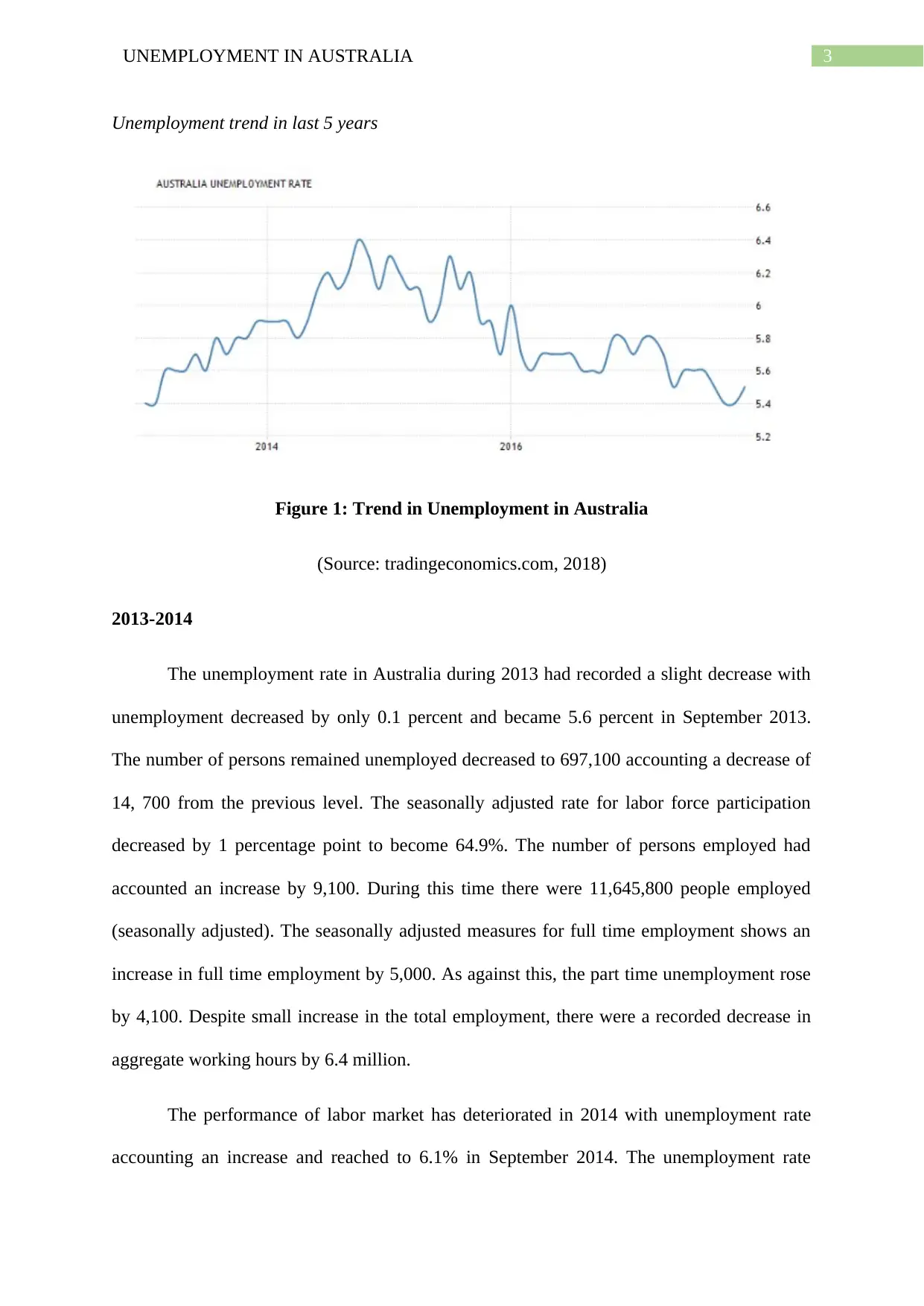
3UNEMPLOYMENT IN AUSTRALIA
Unemployment trend in last 5 years
Figure 1: Trend in Unemployment in Australia
(Source: tradingeconomics.com, 2018)
2013-2014
The unemployment rate in Australia during 2013 had recorded a slight decrease with
unemployment decreased by only 0.1 percent and became 5.6 percent in September 2013.
The number of persons remained unemployed decreased to 697,100 accounting a decrease of
14, 700 from the previous level. The seasonally adjusted rate for labor force participation
decreased by 1 percentage point to become 64.9%. The number of persons employed had
accounted an increase by 9,100. During this time there were 11,645,800 people employed
(seasonally adjusted). The seasonally adjusted measures for full time employment shows an
increase in full time employment by 5,000. As against this, the part time unemployment rose
by 4,100. Despite small increase in the total employment, there were a recorded decrease in
aggregate working hours by 6.4 million.
The performance of labor market has deteriorated in 2014 with unemployment rate
accounting an increase and reached to 6.1% in September 2014. The unemployment rate
Unemployment trend in last 5 years
Figure 1: Trend in Unemployment in Australia
(Source: tradingeconomics.com, 2018)
2013-2014
The unemployment rate in Australia during 2013 had recorded a slight decrease with
unemployment decreased by only 0.1 percent and became 5.6 percent in September 2013.
The number of persons remained unemployed decreased to 697,100 accounting a decrease of
14, 700 from the previous level. The seasonally adjusted rate for labor force participation
decreased by 1 percentage point to become 64.9%. The number of persons employed had
accounted an increase by 9,100. During this time there were 11,645,800 people employed
(seasonally adjusted). The seasonally adjusted measures for full time employment shows an
increase in full time employment by 5,000. As against this, the part time unemployment rose
by 4,100. Despite small increase in the total employment, there were a recorded decrease in
aggregate working hours by 6.4 million.
The performance of labor market has deteriorated in 2014 with unemployment rate
accounting an increase and reached to 6.1% in September 2014. The unemployment rate
Paraphrase This Document
Need a fresh take? Get an instant paraphrase of this document with our AI Paraphraser
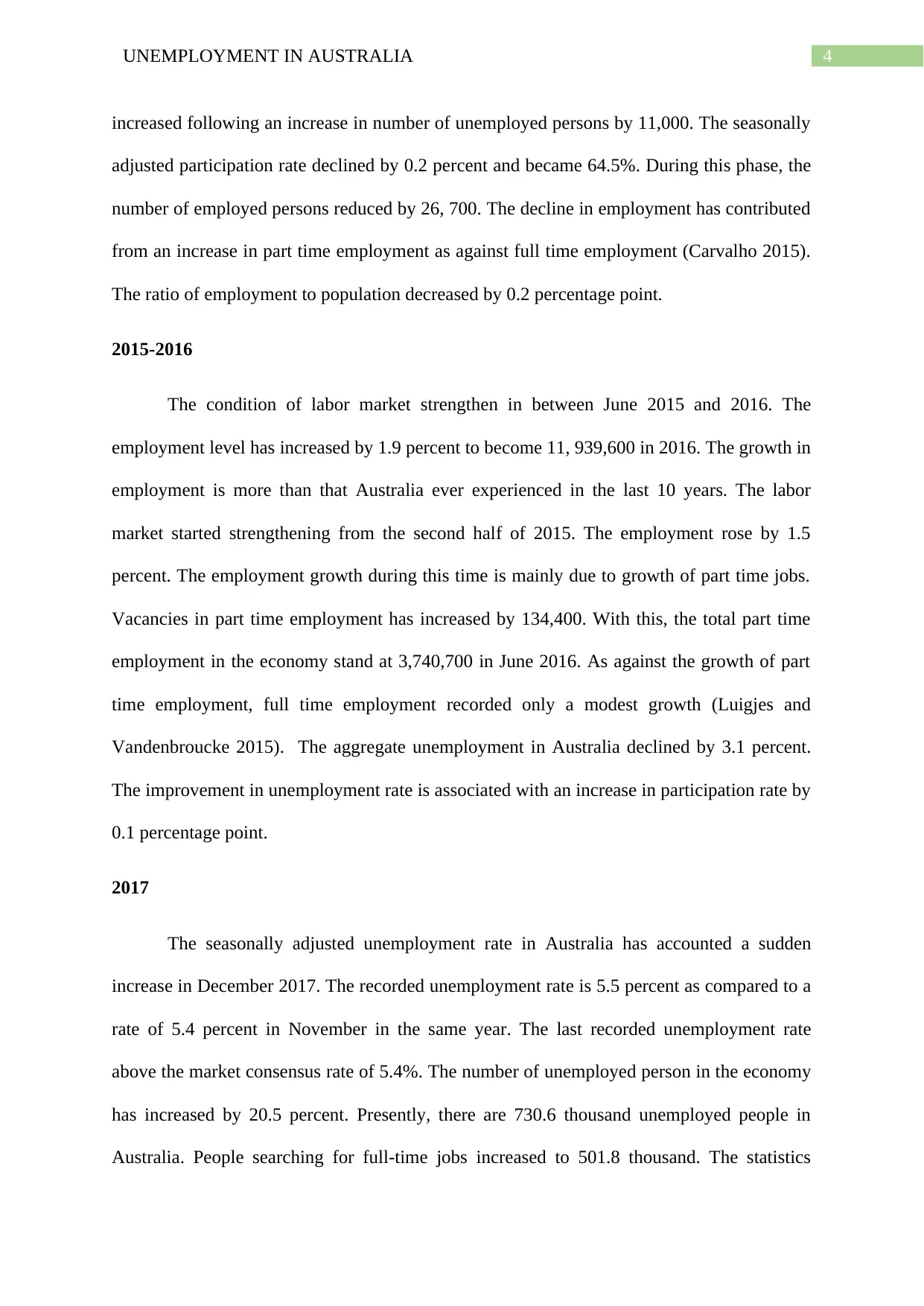
4UNEMPLOYMENT IN AUSTRALIA
increased following an increase in number of unemployed persons by 11,000. The seasonally
adjusted participation rate declined by 0.2 percent and became 64.5%. During this phase, the
number of employed persons reduced by 26, 700. The decline in employment has contributed
from an increase in part time employment as against full time employment (Carvalho 2015).
The ratio of employment to population decreased by 0.2 percentage point.
2015-2016
The condition of labor market strengthen in between June 2015 and 2016. The
employment level has increased by 1.9 percent to become 11, 939,600 in 2016. The growth in
employment is more than that Australia ever experienced in the last 10 years. The labor
market started strengthening from the second half of 2015. The employment rose by 1.5
percent. The employment growth during this time is mainly due to growth of part time jobs.
Vacancies in part time employment has increased by 134,400. With this, the total part time
employment in the economy stand at 3,740,700 in June 2016. As against the growth of part
time employment, full time employment recorded only a modest growth (Luigjes and
Vandenbroucke 2015). The aggregate unemployment in Australia declined by 3.1 percent.
The improvement in unemployment rate is associated with an increase in participation rate by
0.1 percentage point.
2017
The seasonally adjusted unemployment rate in Australia has accounted a sudden
increase in December 2017. The recorded unemployment rate is 5.5 percent as compared to a
rate of 5.4 percent in November in the same year. The last recorded unemployment rate
above the market consensus rate of 5.4%. The number of unemployed person in the economy
has increased by 20.5 percent. Presently, there are 730.6 thousand unemployed people in
Australia. People searching for full-time jobs increased to 501.8 thousand. The statistics
increased following an increase in number of unemployed persons by 11,000. The seasonally
adjusted participation rate declined by 0.2 percent and became 64.5%. During this phase, the
number of employed persons reduced by 26, 700. The decline in employment has contributed
from an increase in part time employment as against full time employment (Carvalho 2015).
The ratio of employment to population decreased by 0.2 percentage point.
2015-2016
The condition of labor market strengthen in between June 2015 and 2016. The
employment level has increased by 1.9 percent to become 11, 939,600 in 2016. The growth in
employment is more than that Australia ever experienced in the last 10 years. The labor
market started strengthening from the second half of 2015. The employment rose by 1.5
percent. The employment growth during this time is mainly due to growth of part time jobs.
Vacancies in part time employment has increased by 134,400. With this, the total part time
employment in the economy stand at 3,740,700 in June 2016. As against the growth of part
time employment, full time employment recorded only a modest growth (Luigjes and
Vandenbroucke 2015). The aggregate unemployment in Australia declined by 3.1 percent.
The improvement in unemployment rate is associated with an increase in participation rate by
0.1 percentage point.
2017
The seasonally adjusted unemployment rate in Australia has accounted a sudden
increase in December 2017. The recorded unemployment rate is 5.5 percent as compared to a
rate of 5.4 percent in November in the same year. The last recorded unemployment rate
above the market consensus rate of 5.4%. The number of unemployed person in the economy
has increased by 20.5 percent. Presently, there are 730.6 thousand unemployed people in
Australia. People searching for full-time jobs increased to 501.8 thousand. The statistics
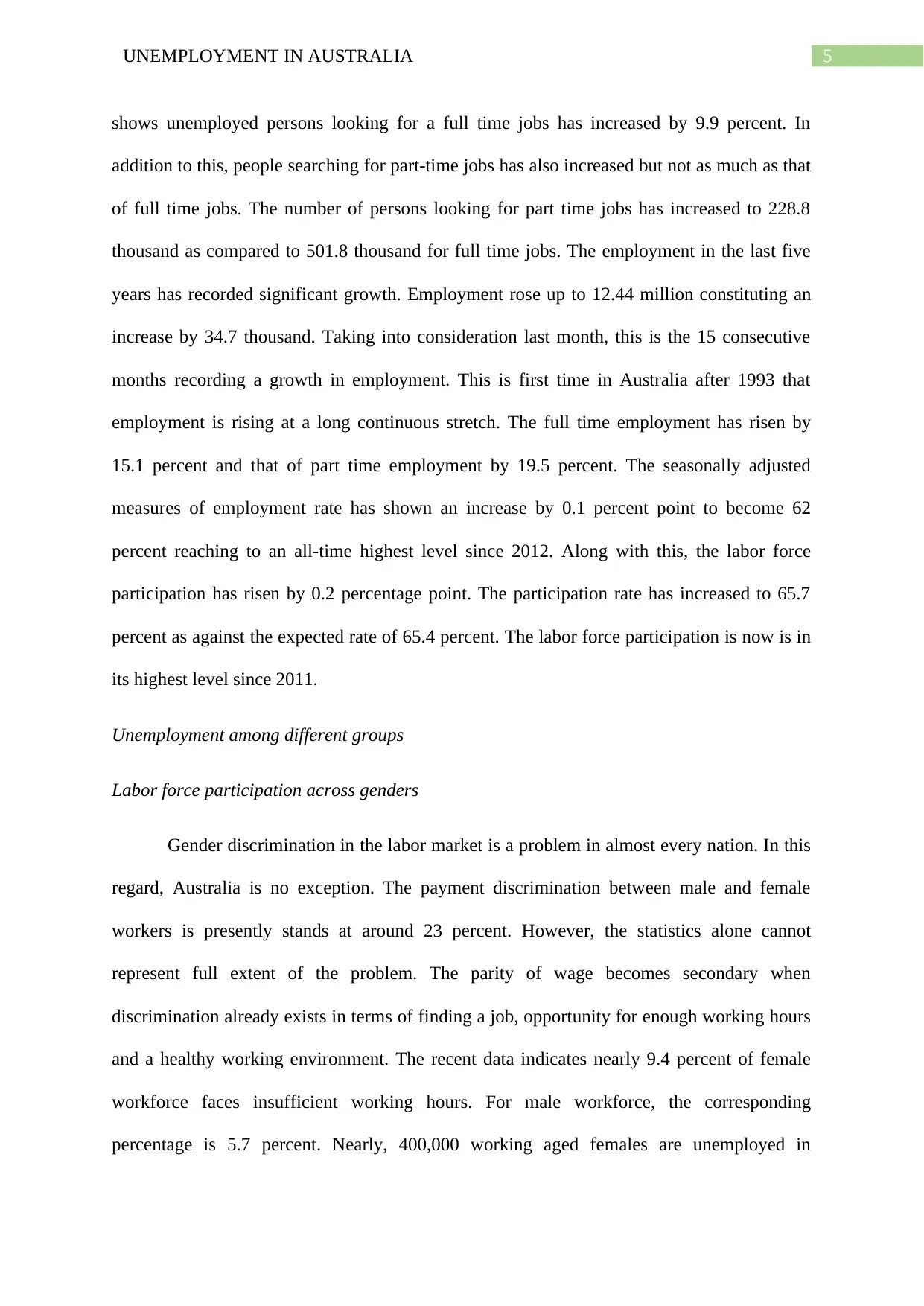
5UNEMPLOYMENT IN AUSTRALIA
shows unemployed persons looking for a full time jobs has increased by 9.9 percent. In
addition to this, people searching for part-time jobs has also increased but not as much as that
of full time jobs. The number of persons looking for part time jobs has increased to 228.8
thousand as compared to 501.8 thousand for full time jobs. The employment in the last five
years has recorded significant growth. Employment rose up to 12.44 million constituting an
increase by 34.7 thousand. Taking into consideration last month, this is the 15 consecutive
months recording a growth in employment. This is first time in Australia after 1993 that
employment is rising at a long continuous stretch. The full time employment has risen by
15.1 percent and that of part time employment by 19.5 percent. The seasonally adjusted
measures of employment rate has shown an increase by 0.1 percent point to become 62
percent reaching to an all-time highest level since 2012. Along with this, the labor force
participation has risen by 0.2 percentage point. The participation rate has increased to 65.7
percent as against the expected rate of 65.4 percent. The labor force participation is now is in
its highest level since 2011.
Unemployment among different groups
Labor force participation across genders
Gender discrimination in the labor market is a problem in almost every nation. In this
regard, Australia is no exception. The payment discrimination between male and female
workers is presently stands at around 23 percent. However, the statistics alone cannot
represent full extent of the problem. The parity of wage becomes secondary when
discrimination already exists in terms of finding a job, opportunity for enough working hours
and a healthy working environment. The recent data indicates nearly 9.4 percent of female
workforce faces insufficient working hours. For male workforce, the corresponding
percentage is 5.7 percent. Nearly, 400,000 working aged females are unemployed in
shows unemployed persons looking for a full time jobs has increased by 9.9 percent. In
addition to this, people searching for part-time jobs has also increased but not as much as that
of full time jobs. The number of persons looking for part time jobs has increased to 228.8
thousand as compared to 501.8 thousand for full time jobs. The employment in the last five
years has recorded significant growth. Employment rose up to 12.44 million constituting an
increase by 34.7 thousand. Taking into consideration last month, this is the 15 consecutive
months recording a growth in employment. This is first time in Australia after 1993 that
employment is rising at a long continuous stretch. The full time employment has risen by
15.1 percent and that of part time employment by 19.5 percent. The seasonally adjusted
measures of employment rate has shown an increase by 0.1 percent point to become 62
percent reaching to an all-time highest level since 2012. Along with this, the labor force
participation has risen by 0.2 percentage point. The participation rate has increased to 65.7
percent as against the expected rate of 65.4 percent. The labor force participation is now is in
its highest level since 2011.
Unemployment among different groups
Labor force participation across genders
Gender discrimination in the labor market is a problem in almost every nation. In this
regard, Australia is no exception. The payment discrimination between male and female
workers is presently stands at around 23 percent. However, the statistics alone cannot
represent full extent of the problem. The parity of wage becomes secondary when
discrimination already exists in terms of finding a job, opportunity for enough working hours
and a healthy working environment. The recent data indicates nearly 9.4 percent of female
workforce faces insufficient working hours. For male workforce, the corresponding
percentage is 5.7 percent. Nearly, 400,000 working aged females are unemployed in
⊘ This is a preview!⊘
Do you want full access?
Subscribe today to unlock all pages.

Trusted by 1+ million students worldwide
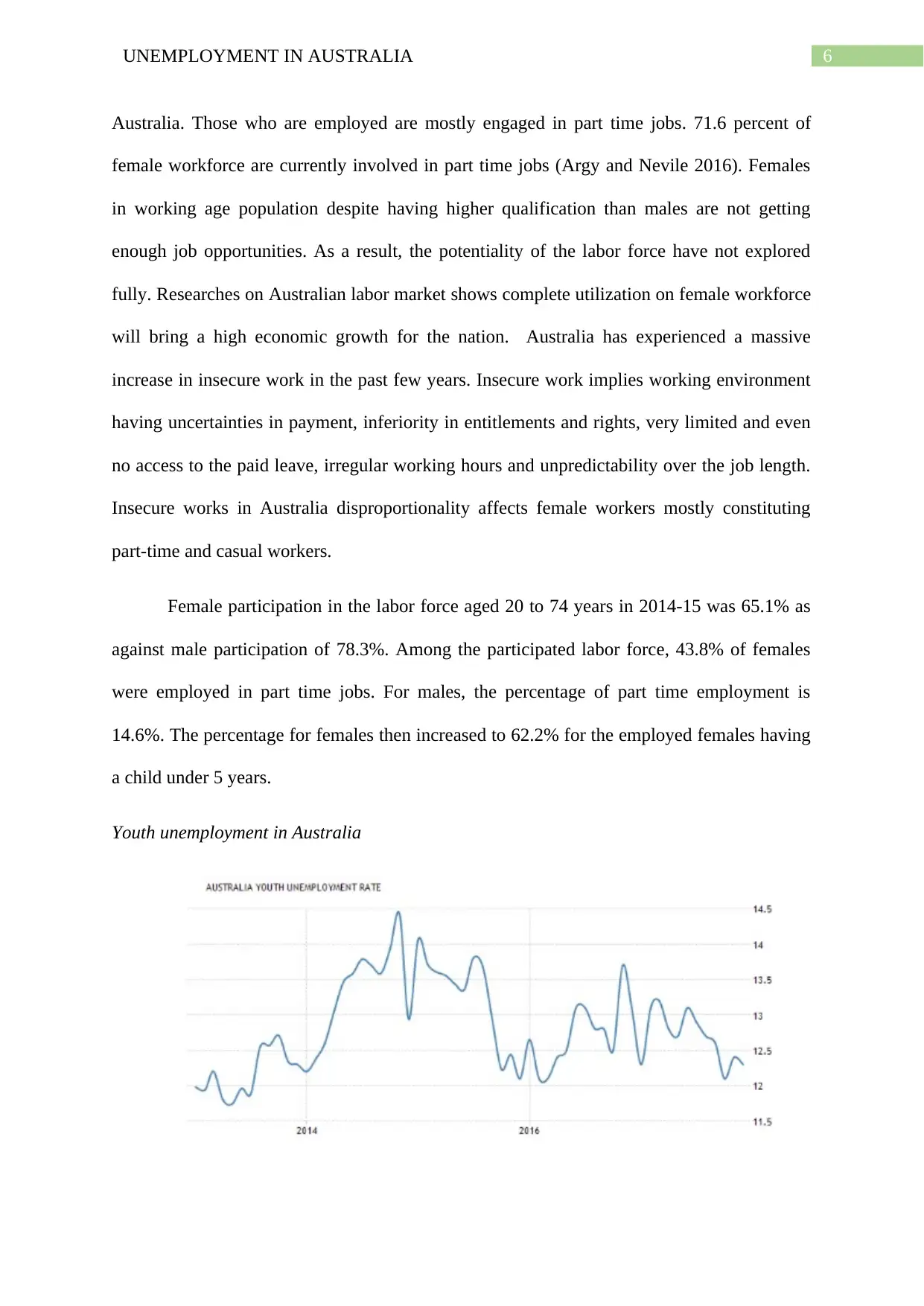
6UNEMPLOYMENT IN AUSTRALIA
Australia. Those who are employed are mostly engaged in part time jobs. 71.6 percent of
female workforce are currently involved in part time jobs (Argy and Nevile 2016). Females
in working age population despite having higher qualification than males are not getting
enough job opportunities. As a result, the potentiality of the labor force have not explored
fully. Researches on Australian labor market shows complete utilization on female workforce
will bring a high economic growth for the nation. Australia has experienced a massive
increase in insecure work in the past few years. Insecure work implies working environment
having uncertainties in payment, inferiority in entitlements and rights, very limited and even
no access to the paid leave, irregular working hours and unpredictability over the job length.
Insecure works in Australia disproportionality affects female workers mostly constituting
part-time and casual workers.
Female participation in the labor force aged 20 to 74 years in 2014-15 was 65.1% as
against male participation of 78.3%. Among the participated labor force, 43.8% of females
were employed in part time jobs. For males, the percentage of part time employment is
14.6%. The percentage for females then increased to 62.2% for the employed females having
a child under 5 years.
Youth unemployment in Australia
Australia. Those who are employed are mostly engaged in part time jobs. 71.6 percent of
female workforce are currently involved in part time jobs (Argy and Nevile 2016). Females
in working age population despite having higher qualification than males are not getting
enough job opportunities. As a result, the potentiality of the labor force have not explored
fully. Researches on Australian labor market shows complete utilization on female workforce
will bring a high economic growth for the nation. Australia has experienced a massive
increase in insecure work in the past few years. Insecure work implies working environment
having uncertainties in payment, inferiority in entitlements and rights, very limited and even
no access to the paid leave, irregular working hours and unpredictability over the job length.
Insecure works in Australia disproportionality affects female workers mostly constituting
part-time and casual workers.
Female participation in the labor force aged 20 to 74 years in 2014-15 was 65.1% as
against male participation of 78.3%. Among the participated labor force, 43.8% of females
were employed in part time jobs. For males, the percentage of part time employment is
14.6%. The percentage for females then increased to 62.2% for the employed females having
a child under 5 years.
Youth unemployment in Australia
Paraphrase This Document
Need a fresh take? Get an instant paraphrase of this document with our AI Paraphraser
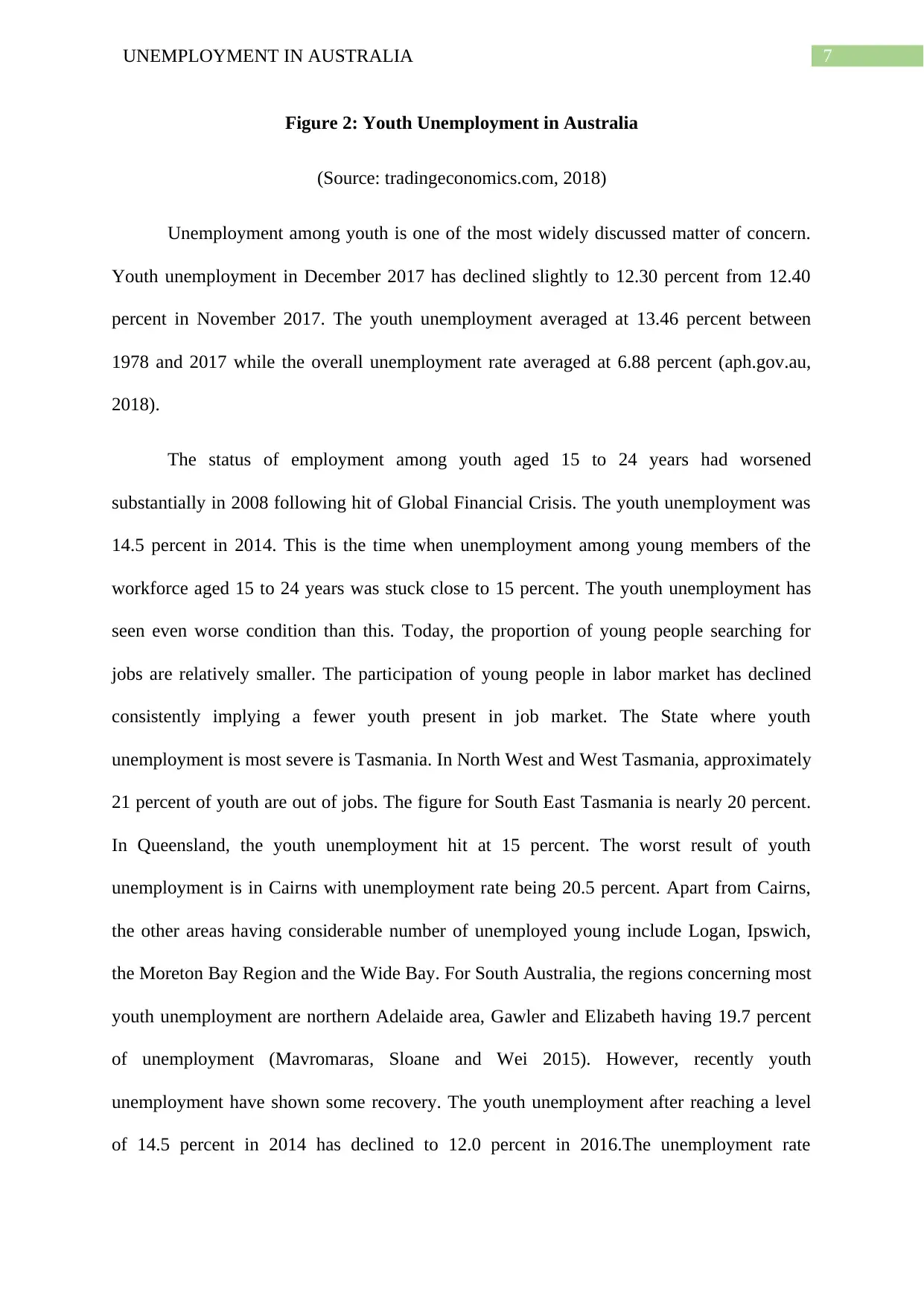
7UNEMPLOYMENT IN AUSTRALIA
Figure 2: Youth Unemployment in Australia
(Source: tradingeconomics.com, 2018)
Unemployment among youth is one of the most widely discussed matter of concern.
Youth unemployment in December 2017 has declined slightly to 12.30 percent from 12.40
percent in November 2017. The youth unemployment averaged at 13.46 percent between
1978 and 2017 while the overall unemployment rate averaged at 6.88 percent (aph.gov.au,
2018).
The status of employment among youth aged 15 to 24 years had worsened
substantially in 2008 following hit of Global Financial Crisis. The youth unemployment was
14.5 percent in 2014. This is the time when unemployment among young members of the
workforce aged 15 to 24 years was stuck close to 15 percent. The youth unemployment has
seen even worse condition than this. Today, the proportion of young people searching for
jobs are relatively smaller. The participation of young people in labor market has declined
consistently implying a fewer youth present in job market. The State where youth
unemployment is most severe is Tasmania. In North West and West Tasmania, approximately
21 percent of youth are out of jobs. The figure for South East Tasmania is nearly 20 percent.
In Queensland, the youth unemployment hit at 15 percent. The worst result of youth
unemployment is in Cairns with unemployment rate being 20.5 percent. Apart from Cairns,
the other areas having considerable number of unemployed young include Logan, Ipswich,
the Moreton Bay Region and the Wide Bay. For South Australia, the regions concerning most
youth unemployment are northern Adelaide area, Gawler and Elizabeth having 19.7 percent
of unemployment (Mavromaras, Sloane and Wei 2015). However, recently youth
unemployment have shown some recovery. The youth unemployment after reaching a level
of 14.5 percent in 2014 has declined to 12.0 percent in 2016.The unemployment rate
Figure 2: Youth Unemployment in Australia
(Source: tradingeconomics.com, 2018)
Unemployment among youth is one of the most widely discussed matter of concern.
Youth unemployment in December 2017 has declined slightly to 12.30 percent from 12.40
percent in November 2017. The youth unemployment averaged at 13.46 percent between
1978 and 2017 while the overall unemployment rate averaged at 6.88 percent (aph.gov.au,
2018).
The status of employment among youth aged 15 to 24 years had worsened
substantially in 2008 following hit of Global Financial Crisis. The youth unemployment was
14.5 percent in 2014. This is the time when unemployment among young members of the
workforce aged 15 to 24 years was stuck close to 15 percent. The youth unemployment has
seen even worse condition than this. Today, the proportion of young people searching for
jobs are relatively smaller. The participation of young people in labor market has declined
consistently implying a fewer youth present in job market. The State where youth
unemployment is most severe is Tasmania. In North West and West Tasmania, approximately
21 percent of youth are out of jobs. The figure for South East Tasmania is nearly 20 percent.
In Queensland, the youth unemployment hit at 15 percent. The worst result of youth
unemployment is in Cairns with unemployment rate being 20.5 percent. Apart from Cairns,
the other areas having considerable number of unemployed young include Logan, Ipswich,
the Moreton Bay Region and the Wide Bay. For South Australia, the regions concerning most
youth unemployment are northern Adelaide area, Gawler and Elizabeth having 19.7 percent
of unemployment (Mavromaras, Sloane and Wei 2015). However, recently youth
unemployment have shown some recovery. The youth unemployment after reaching a level
of 14.5 percent in 2014 has declined to 12.0 percent in 2016.The unemployment rate
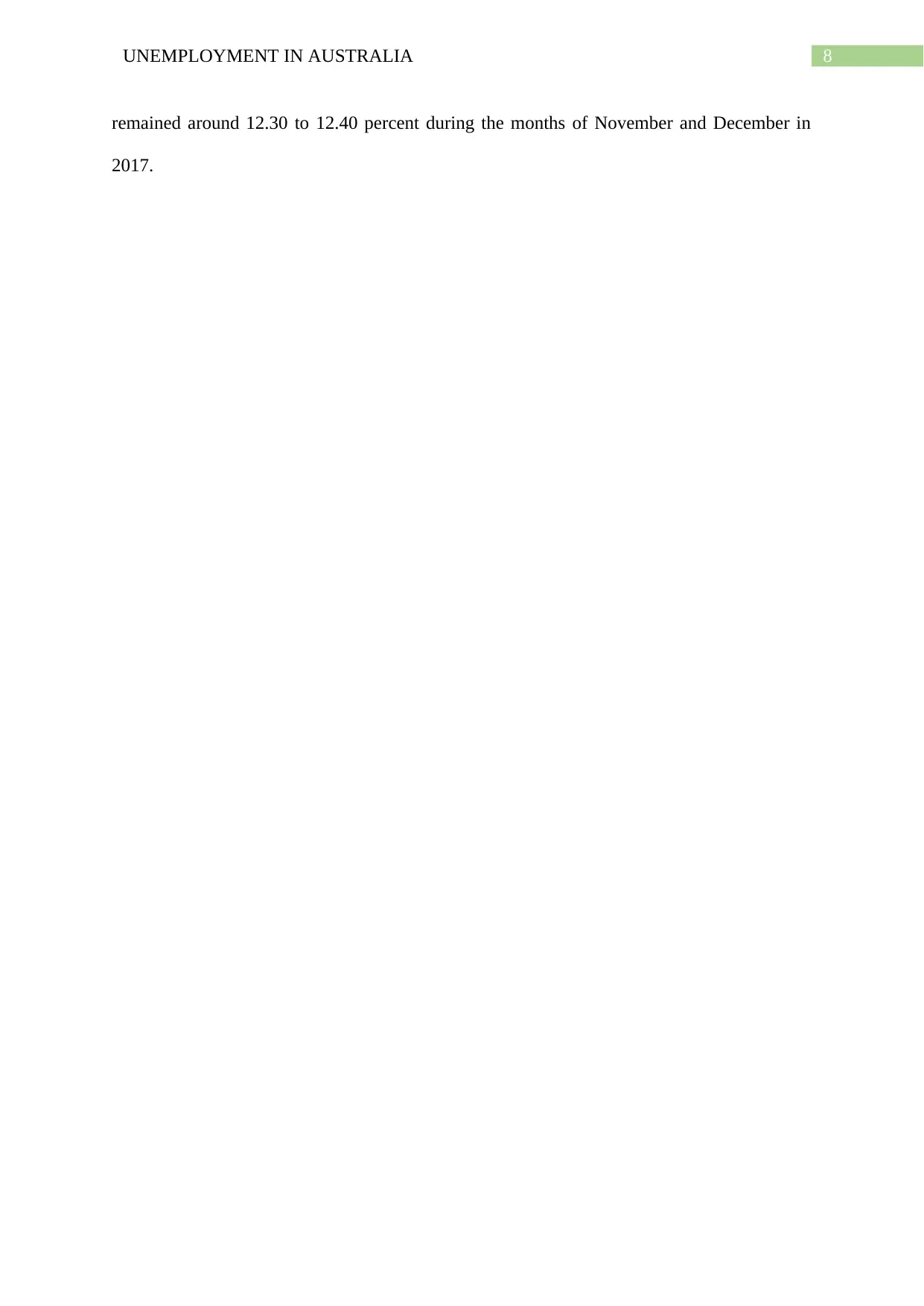
8UNEMPLOYMENT IN AUSTRALIA
remained around 12.30 to 12.40 percent during the months of November and December in
2017.
remained around 12.30 to 12.40 percent during the months of November and December in
2017.
⊘ This is a preview!⊘
Do you want full access?
Subscribe today to unlock all pages.

Trusted by 1+ million students worldwide
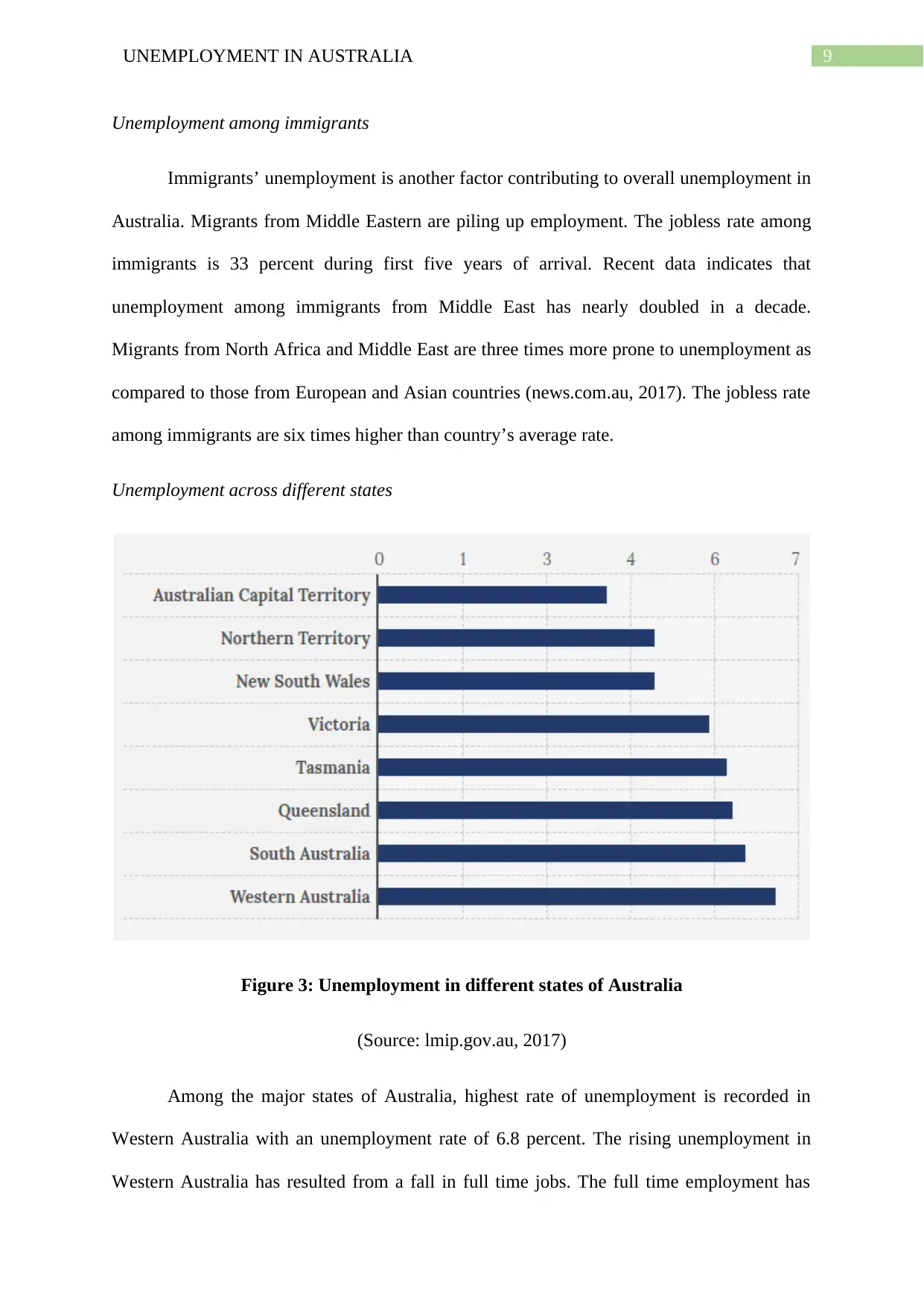
9UNEMPLOYMENT IN AUSTRALIA
Unemployment among immigrants
Immigrants’ unemployment is another factor contributing to overall unemployment in
Australia. Migrants from Middle Eastern are piling up employment. The jobless rate among
immigrants is 33 percent during first five years of arrival. Recent data indicates that
unemployment among immigrants from Middle East has nearly doubled in a decade.
Migrants from North Africa and Middle East are three times more prone to unemployment as
compared to those from European and Asian countries (news.com.au, 2017). The jobless rate
among immigrants are six times higher than country’s average rate.
Unemployment across different states
Figure 3: Unemployment in different states of Australia
(Source: lmip.gov.au, 2017)
Among the major states of Australia, highest rate of unemployment is recorded in
Western Australia with an unemployment rate of 6.8 percent. The rising unemployment in
Western Australia has resulted from a fall in full time jobs. The full time employment has
Unemployment among immigrants
Immigrants’ unemployment is another factor contributing to overall unemployment in
Australia. Migrants from Middle Eastern are piling up employment. The jobless rate among
immigrants is 33 percent during first five years of arrival. Recent data indicates that
unemployment among immigrants from Middle East has nearly doubled in a decade.
Migrants from North Africa and Middle East are three times more prone to unemployment as
compared to those from European and Asian countries (news.com.au, 2017). The jobless rate
among immigrants are six times higher than country’s average rate.
Unemployment across different states
Figure 3: Unemployment in different states of Australia
(Source: lmip.gov.au, 2017)
Among the major states of Australia, highest rate of unemployment is recorded in
Western Australia with an unemployment rate of 6.8 percent. The rising unemployment in
Western Australia has resulted from a fall in full time jobs. The full time employment has
Paraphrase This Document
Need a fresh take? Get an instant paraphrase of this document with our AI Paraphraser
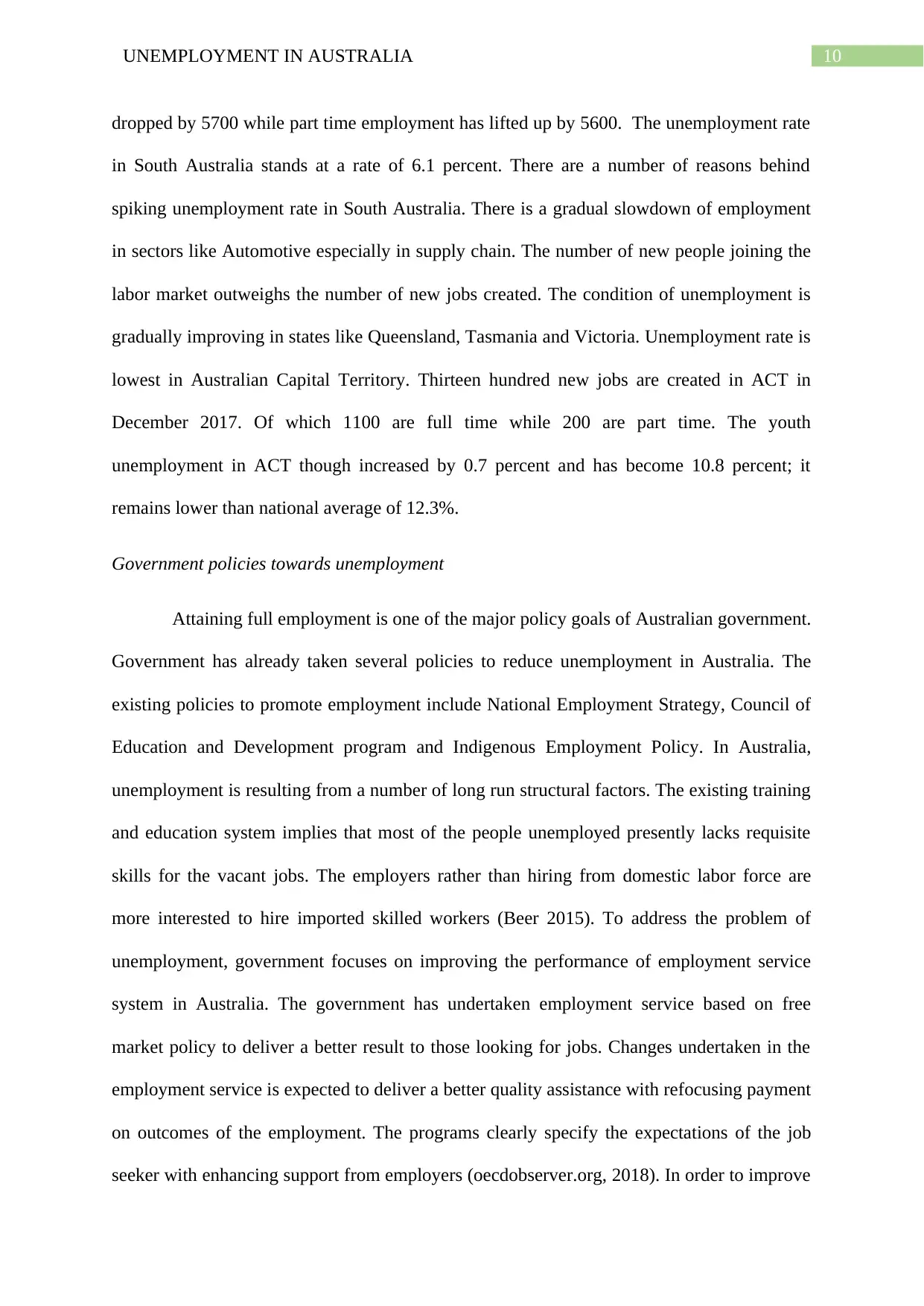
10UNEMPLOYMENT IN AUSTRALIA
dropped by 5700 while part time employment has lifted up by 5600. The unemployment rate
in South Australia stands at a rate of 6.1 percent. There are a number of reasons behind
spiking unemployment rate in South Australia. There is a gradual slowdown of employment
in sectors like Automotive especially in supply chain. The number of new people joining the
labor market outweighs the number of new jobs created. The condition of unemployment is
gradually improving in states like Queensland, Tasmania and Victoria. Unemployment rate is
lowest in Australian Capital Territory. Thirteen hundred new jobs are created in ACT in
December 2017. Of which 1100 are full time while 200 are part time. The youth
unemployment in ACT though increased by 0.7 percent and has become 10.8 percent; it
remains lower than national average of 12.3%.
Government policies towards unemployment
Attaining full employment is one of the major policy goals of Australian government.
Government has already taken several policies to reduce unemployment in Australia. The
existing policies to promote employment include National Employment Strategy, Council of
Education and Development program and Indigenous Employment Policy. In Australia,
unemployment is resulting from a number of long run structural factors. The existing training
and education system implies that most of the people unemployed presently lacks requisite
skills for the vacant jobs. The employers rather than hiring from domestic labor force are
more interested to hire imported skilled workers (Beer 2015). To address the problem of
unemployment, government focuses on improving the performance of employment service
system in Australia. The government has undertaken employment service based on free
market policy to deliver a better result to those looking for jobs. Changes undertaken in the
employment service is expected to deliver a better quality assistance with refocusing payment
on outcomes of the employment. The programs clearly specify the expectations of the job
seeker with enhancing support from employers (oecdobserver.org, 2018). In order to improve
dropped by 5700 while part time employment has lifted up by 5600. The unemployment rate
in South Australia stands at a rate of 6.1 percent. There are a number of reasons behind
spiking unemployment rate in South Australia. There is a gradual slowdown of employment
in sectors like Automotive especially in supply chain. The number of new people joining the
labor market outweighs the number of new jobs created. The condition of unemployment is
gradually improving in states like Queensland, Tasmania and Victoria. Unemployment rate is
lowest in Australian Capital Territory. Thirteen hundred new jobs are created in ACT in
December 2017. Of which 1100 are full time while 200 are part time. The youth
unemployment in ACT though increased by 0.7 percent and has become 10.8 percent; it
remains lower than national average of 12.3%.
Government policies towards unemployment
Attaining full employment is one of the major policy goals of Australian government.
Government has already taken several policies to reduce unemployment in Australia. The
existing policies to promote employment include National Employment Strategy, Council of
Education and Development program and Indigenous Employment Policy. In Australia,
unemployment is resulting from a number of long run structural factors. The existing training
and education system implies that most of the people unemployed presently lacks requisite
skills for the vacant jobs. The employers rather than hiring from domestic labor force are
more interested to hire imported skilled workers (Beer 2015). To address the problem of
unemployment, government focuses on improving the performance of employment service
system in Australia. The government has undertaken employment service based on free
market policy to deliver a better result to those looking for jobs. Changes undertaken in the
employment service is expected to deliver a better quality assistance with refocusing payment
on outcomes of the employment. The programs clearly specify the expectations of the job
seeker with enhancing support from employers (oecdobserver.org, 2018). In order to improve
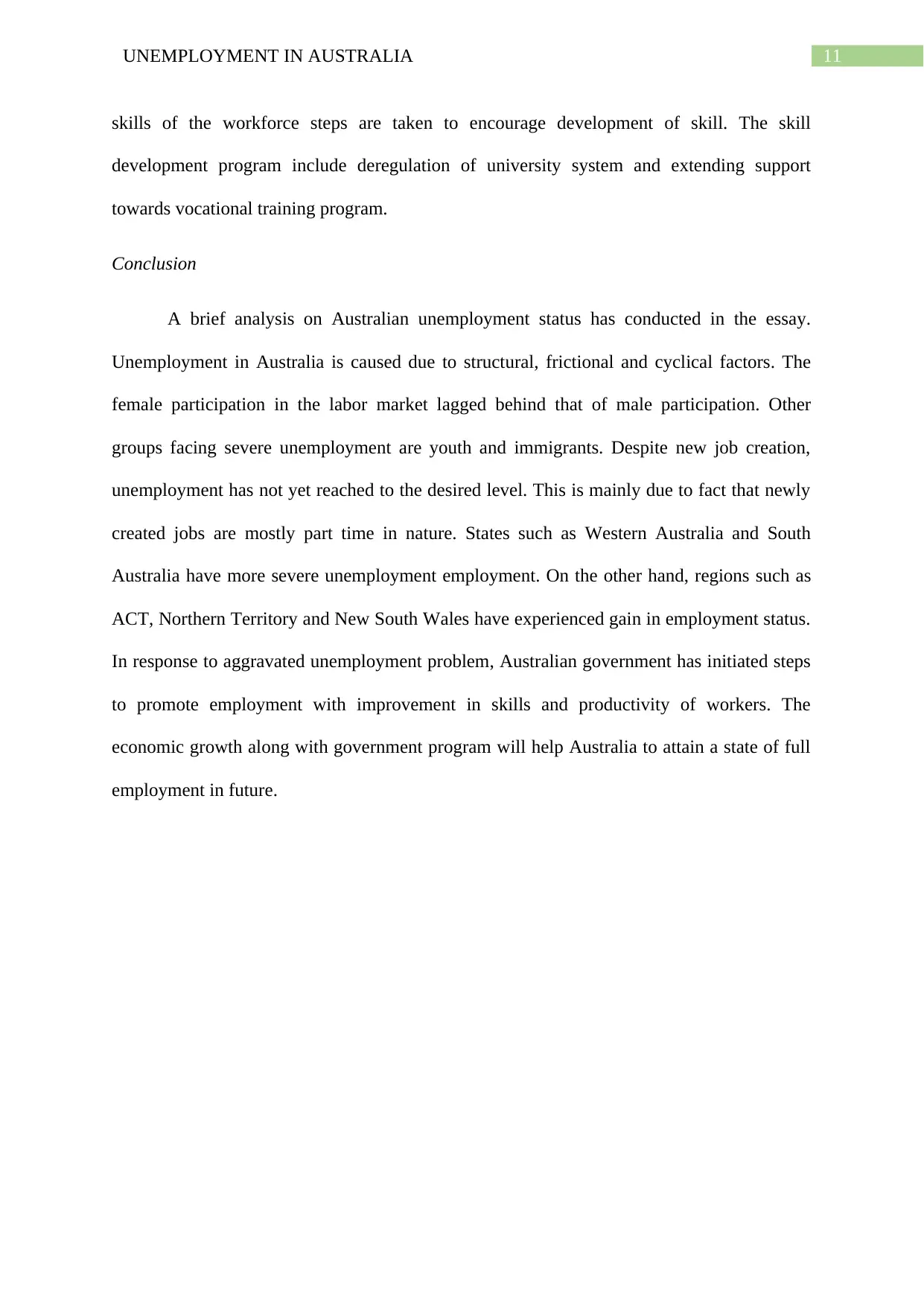
11UNEMPLOYMENT IN AUSTRALIA
skills of the workforce steps are taken to encourage development of skill. The skill
development program include deregulation of university system and extending support
towards vocational training program.
Conclusion
A brief analysis on Australian unemployment status has conducted in the essay.
Unemployment in Australia is caused due to structural, frictional and cyclical factors. The
female participation in the labor market lagged behind that of male participation. Other
groups facing severe unemployment are youth and immigrants. Despite new job creation,
unemployment has not yet reached to the desired level. This is mainly due to fact that newly
created jobs are mostly part time in nature. States such as Western Australia and South
Australia have more severe unemployment employment. On the other hand, regions such as
ACT, Northern Territory and New South Wales have experienced gain in employment status.
In response to aggravated unemployment problem, Australian government has initiated steps
to promote employment with improvement in skills and productivity of workers. The
economic growth along with government program will help Australia to attain a state of full
employment in future.
skills of the workforce steps are taken to encourage development of skill. The skill
development program include deregulation of university system and extending support
towards vocational training program.
Conclusion
A brief analysis on Australian unemployment status has conducted in the essay.
Unemployment in Australia is caused due to structural, frictional and cyclical factors. The
female participation in the labor market lagged behind that of male participation. Other
groups facing severe unemployment are youth and immigrants. Despite new job creation,
unemployment has not yet reached to the desired level. This is mainly due to fact that newly
created jobs are mostly part time in nature. States such as Western Australia and South
Australia have more severe unemployment employment. On the other hand, regions such as
ACT, Northern Territory and New South Wales have experienced gain in employment status.
In response to aggravated unemployment problem, Australian government has initiated steps
to promote employment with improvement in skills and productivity of workers. The
economic growth along with government program will help Australia to attain a state of full
employment in future.
⊘ This is a preview!⊘
Do you want full access?
Subscribe today to unlock all pages.

Trusted by 1+ million students worldwide
1 out of 14
Related Documents
Your All-in-One AI-Powered Toolkit for Academic Success.
+13062052269
info@desklib.com
Available 24*7 on WhatsApp / Email
![[object Object]](/_next/static/media/star-bottom.7253800d.svg)
Unlock your academic potential
Copyright © 2020–2025 A2Z Services. All Rights Reserved. Developed and managed by ZUCOL.




